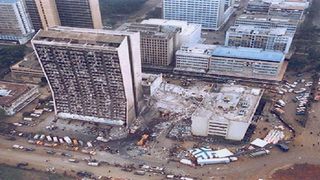
An aerial view of the US Embassy in Nairobi following the bombing on August 7, 1998.
| File | ReutersNews
Premium
With al-Masri dead, only two 1998 blast suspects remain
What you need to know:
- Abu Muhammad al-Masri also known as Abdullah Ahmed Abdullah, Al-Qaeda’s second-highest leader, was killed in Iran three months ago, according to the New York Times.
- Al-Masri was gunned down in the streets of Tehran by two assassins on August 7, the anniversary of the embassy attacks in Nairobi and Tanzania
With the revelations that Abu Muhammad al-Masri has been killed, only Ayman Al Zawahiri and Saif Al Adel are yet to be brought to justice from the 21 suspects wanted for the 1998 Nairobi bomb blast that left more than 250 people dead and about 5,000 injured.
Abu Muhammad al-Masri also known as Abdullah Ahmed Abdullah, Al-Qaeda’s second-highest leader, was killed in Iran three months ago, according to the New York Times.
Al-Masri was gunned down in the streets of Tehran by two assassins on August 7, the anniversary of the embassy attacks in Nairobi and Tanzania.
“He was killed along with his daughter, Miriam, the widow of Osama bin Laden’s son Hamza bin Laden. The attack was carried out by Israeli operatives at the behest of the United States, according to four of the officials,” the New York Times reported.
Long featured on the FBI’s Most Wanted Terrorist List and with a $10 million reward for information leading to his capture, Al-Masri was among the only three other suspects who had not been captured or killed.
Egyptian terrorist
The other one is Ayman Al Zawahiri, the Egyptian terrorist who succeeded al-Qaeda founder Osama bin Laden after his death. There is also Saif Al Adel also known as Mohammad Ibrahim al-Makkawi, a veteran of the Egyptian military who is believed to be under house arrest in Iran.
Since the attacks, 18 of the suspects have since been hunted down.
Topmost on the list was Osama bin Laden, who was shot and killed by the US Navy Seals in 2011 in Pakistan.
Mohamed Atef, one of Bin Laden’s deputies, was killed in an air strike on his home near Kabul, Afghanistan in mid-November 2001.
Notably, Atef , who also served in the Egyptian Air Force, had travelled to Mombasa where he met Mohammed Odeh, one of the masterminds of the Nairobi attack.
The other attacker, Fazul Mohammed, was killed in Afgoye, Somalia, by Somali government forces after he refused to stop at a roadblock in June 2011.
Kenyan operative
Apparently Fazul, who was in the company of a Kenyan operative, missed a turn on a road in the Afgoye corridor past Mogadishu and instead of heading to Al-Shabaab controlled areas, he ended up at a security checkpoint run by the Somalia military. After disobeying orders to stop, the terrorists opened fire on the Somalia government troops who in turn shot back and killed Fazul.
Muhsin Musa Matwalli Atwah, a feared bomb maker who built the bombs used in the Nairobi and Dar es Salaam attacks was killed on April 12, 2006, following a raid in a remote village in Pakistan.
Ahmed Mohamed Hamed Ali, who fled Kenya to Karachi, Pakistan, on August 2, 1998 — a day after the attacks — was killed in a drone strike in Pakistan.
Before the 1998 attacks, Hamed Ali, a man with 13 known aliases, was part of a team that attacked US forces in Somalia in 1993.
Other suspects Ahmed Khalfain Ghailani, Khalfan Khamis Mohamed and Mohamed Odeh are serving various sentences in jail.
Mohamed Odeh, who was arrested trying to enter Pakistan with a fake Yemeni passport, is currently incarcerated in the United States Penitentiary in Coleman, Florida. Odeh, who came to Kenya in 1994, was married to a Kenyan woman and stayed in Witu, Lamu County. Upon his arrest, he told investigators that he provided technical and logistical support to the bombers.
Ahmed Khalfain Ghailani was arrested in July 2004 in Pakistan and transferred to the Guantanamo Bay in September 2006. He was one of 17 high-value detainees at Guantanamo Bay before his transfer to a US prison on June 9, 2009.
Khalfan Khamis Mohamed, a Tanzanian national, is currently held in the US supermax prison known as ADX Florence.
The attacks are believed to have been organized in several countries among them Sudan.
Last month, US President Donald Trump announced on that the United States would remove Sudan from its list of state sponsors of terrorism as soon as Khartoum sets aside the Sh36.4billion) it has agreed to pay to the victims of the 1998 bomb attacks.





